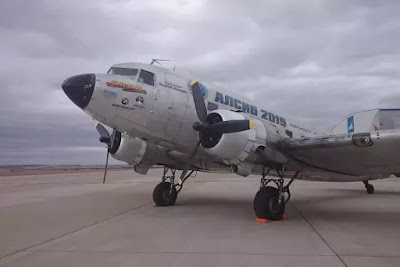Tupolev Tu-144 Supersonic airliner The legendary passenger aircraft, capable of flying at speeds twice the speed of sound. It made its...
- Tupolev Tu-144 Supersonic airliner
2. VMT-Atlant
A heavy transport aircraft, developed in the design office of Vladimir Myasishchev based strategic bomber 3M. The main objective of this was to deliver a giant spaceship “Buran” and elements of the rocket “Energy” from the production site to the Baikonur Cosmodrome. Due to its aerodynamic efficiency the aircraft could carry cargo up to 50 tons much larger in the diameter than the fuselage of the aircraft. For example, the diameter of the hydrogen tank of the “Energy” rocket is 7.7 meters and the diameter of the fuselage of the aircraft is 3 meters. Two aircraft were constructed. Together they made 152 flights to the Baikonur Cosmodrome and back.
3. Tupolev Tu-155 alternative fuel testbed
It was a flying laboratory based on a Tu-154 airliner, used to finalize and check systems and engines, which work on cryogenic fuels. These activities were carried out in the end of the 1980s. Tu-155 was the first aircraft in the world which used liquid hydrogen and liquefied natural gas as a fuel. It was equipped with experimental bypass turbocharge engine NK-88 constructed in Samara engine design and manufacturing bureau led by Nikolay Kuznetsov, based on the regular engine for Tu-154 NK-8-2. It was mounted instead of the right operational engine and used liquid hydrogen and liquefied natural gas. The other two engines were operational and worked on kerosene. It made its first flight on April 15, 1988.
4. MIG Project 1.44 MFI
It was an technology demonstrator fighter developed at MiG experimental design office, incorporating many fifth-generation jet fighter aspects such as advanced avionics, stealth technology, super maneuverability and supercruise. Its engineering began earlier than that of F-22, an American fighter. And the first public display was to take place 20 years ago–at the International Aviation and Space Salon MAKS 1995. But it was canceled just a few hours before the beginning of the air show. The second try to demonstrate the experimental fighter was two years later, at the Aviation and Space Salon MAKS 1997. But again the aircraft was not presented to visitors. It made it first flight on February 29, 2000.
5. MIG-25
The MiG-25 was a supersonic interceptor and reconnaissance aircraft that was among the fastest military aircraft to enter service, created in the 1960s. It performed flights at speeds three times higher than the speed of sound. In 1976, after lieutenant Belenko defected to Japan with his MiG-25P, the Government of the USSR issued a resolution on urgent modernization of this interceptor that was in service with the National Air Force. As a result, the aircraft was equipped with the new weapon system and engines. The new modification was named MiG-25PD which meant “interceptor improved”. The aircraft plant in Gorkiy manufactured the aircraft until the switch-over to manufacture of MiG-31, a new interceptor.
6. Sukhoi Su-27
The Su-27 is a highly-maneuverable fighter designed for air-superiority and ground attack and was the ancestor of the whole family of Soviet and then Russian fighters which now include the Su-30, Su-33, Su-34, Su-35 and Su-37. It entered service with Soviet Air Force in 1985, and was the first Russian aircraft to sport a statically unstable configuration. The trim setting was ensured due to automatic quadruplex-redundant fly-by-wire system. Due to that Su-27 demonstrated exceptional maneuverability, outclassing its U.S. analogues.
7. Sukhoi Su-15UM
The trainer variant of the Sukhoi Su-15 twin-engined supersonic interceptor developed by the Soviet Union in the 1960s to replace the Sukhoi Su-11 and Sukhoi Su-9. Unlike the previous modification Su-15UT, which was only a trainer, the Su-15UM had combat capability. Reduction of electronic equipment content allowed constructing an instructor’s cab without making the fuselage longer and even without fuel tank volume reduction.
8. Douglas C-47 Skytrain
Douglas C-47 Skytrain is an American cargo carrier designed by Douglas Aircraft Company. It was constructed on the base of the legendary passenger DC-3, the first flight of which was on December 17, 1935. DC-3 was one of the most popular aircraft of that time, over 16,000 aircraft were constructed. It was also manufactured under license in the USSR under names PS-84 and Li-2. During the Great Patriotic War over 700 aircraft were delivered to the USSR under the lend-lease program. Aircraft flew the route from Alaska to Siberia and then flew to the front line where they delivered cargos, evacuated the injured persons, paradropped.


















